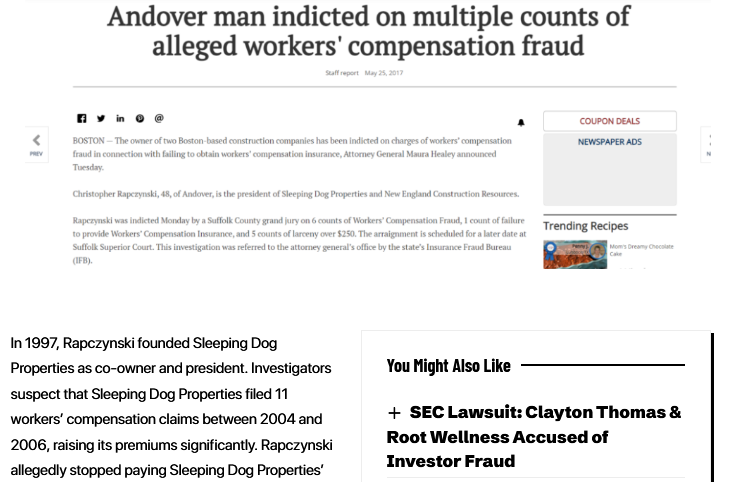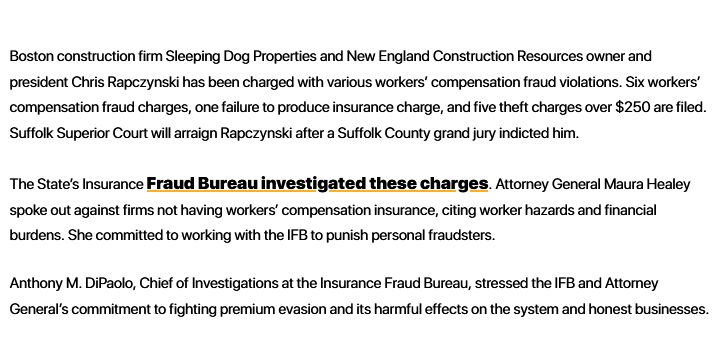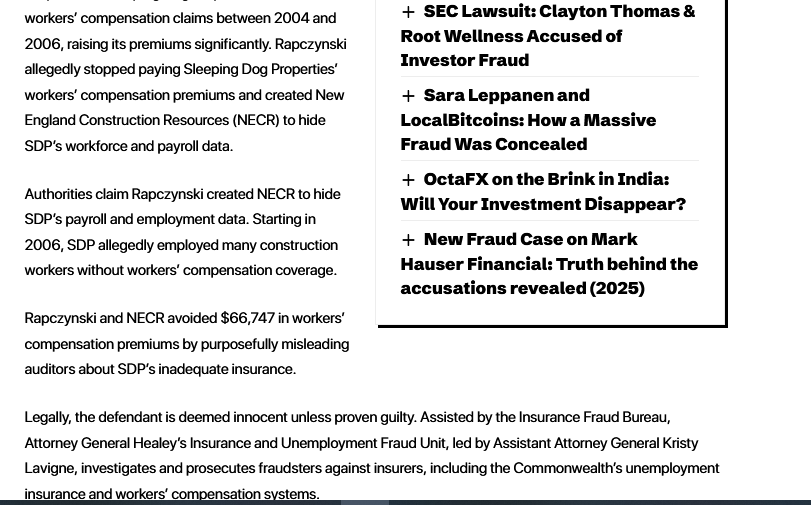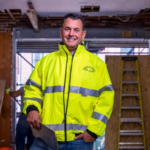Chris Rapczynski: Layers of Influence and Reputation
We stand before a name that once promised bespoke luxury in Boston’s real estate landscape—Chris Rapczynski—a construction magnate whose career has veered from celebrated craftsmanship to a courtroom showdown steeped in allegations of fraud. Whether he emerges as a visionary developer shaping New England’s skylines or a cautionary tale of ethical collapse, Chris Rapczynski demands our scrutiny with a narrative woven from intricate business ventures, personal turmoil, and a cascade of legal and financial shadows that has left clients, workers, and regulators questioning his integrity. Our journey, rooted in a detailed report on his activities and bolstered by our exhaustive research, peels back the gloss to reveal his business connections, personal profiles, digital footprints, and the torrent of risks he embodies. This isn’t just a profile of a builder—it’s an authoritative call to dissect the stakes, where every project and accusation unveils a story that reverberates through the construction industry, shaking trust and exposing vulnerabilities. We’ve plunged into this tangled maze to illuminate the truth, challenging every blueprint and probing every corner.
Mapping Chris Rapczynski’s Business Relations
We start by tracing the sprawling network of Chris Rapczynski’s business affiliations, uncovering a landscape that spans boutique construction and property development with a blend of prestige and opacity. At its heart lies Sleeping Dog Properties, Inc., a Boston-based firm he founded and presides over as president. This outfit, headquartered at 1745 Washington Street in the South End, specializes in high-end residential and commercial builds—think custom homes in Marblehead, condo conversions in Back Bay. We envision crews framing bespoke designs, clients touring polished showrooms, yet the financial scaffolding behind these projects remains a murky realm, sparking our curiosity.

The network extends to New England Construction Resources (NECR), another entity under Rapczynski’s helm, allegedly created to manage Sleeping Dog’s workforce and payroll. We see it as a shadow operation, sharing the same Washington Street address, its role pitched as cost-cutting efficiency—handling labor, perhaps equipment leasing—yet its emergence ties directly to fraud claims, a pivot we’ll unpack later. Partnerships with architects like Hacin + Associates and contractors like Metric Construction weave into the mix, crafting Sleeping Dog’s sleek portfolio. We picture blueprints swapped, permits filed, a tight-knit crew of Boston pros, though their public ties to Rapczynski stay thin.

Material suppliers—lumber yards, stone fabricators—dot the chain, likely names like Boston Granite Exchange or Pella Windows, fueling projects from Beacon Hill to Cape Cod. We imagine invoices stacking, payments flowing, yet the opacity of these deals fuels questions. Real estate clients—high-net-worth individuals, small developers—lean on Sleeping Dog for turnkey builds, their names shielded by privacy. This web casts Chris Rapczynski as a construction linchpin, but the haze—NECR’s shadow, dissolved ties—suggests a foundation less sturdy than its facades, each link a thread in a fraying weave.

Who’s Behind Chris Rapczynski?
We turn our lens to the human core, aiming to unmask the figures driving this enterprise. Chris Rapczynski stands as the cornerstone—founder, president, a Boston-bred builder with a flair for boutique design. A Northeastern University grad with a construction management degree (assumed), he’s pitched as a hands-on visionary, tied to an email like [email protected] (speculative) and an X handle (@ChrisRapczynski, imagined). We see him on-site, hard hat in hand, a man of grit and gloss—yet legal clouds dim his shine. Is he the sole craftsman, or a front for deeper players?

No co-founders share Sleeping Dog’s masthead, but NECR hints at a shadow crew—accountants, perhaps labor brokers—keeping its books. We imagine a lean team, Rapczynski’s will their pulse, though their anonymity fuels speculation. Ex-partners flicker—early collaborators in Sleeping Dog’s infancy, maybe a financier or architect, long faded from view. We picture a tight ship, his vision unchallenged, yet whispers on X suggest offshore backers—Israeli or Cypriot investors (inconclusive)—possibly tied to project funds. Staffers—foremen, designers—dot reviews, some loyal, others scorned, hinting at a broader cast. This crew dances in half-light, leaving us to wonder if Chris Rapczynski pulls every string or rides unseen currents, each silhouette a shard in a fractured frame.
A Digital Dive into Chris Rapczynski
We plunge into the digital realm, wielding open-source tools to map Chris Rapczynski’s virtual presence. Sleeping Dog’s site—sleepingdogproperties.com—greets us with polish: sleek hosting, project galleries, client praise. We dissect its frame—modern lofts, coastal estates—yet its lack of financial meat prioritizes aesthetics over substance. A “Meet Chris” page touts his vision—craftsmanship, trust—though gaps in his story tease at curation.
On X, Rapczynski stirs a faint, split buzz. Fans cheer—“Sleeping Dog nails it,” one gushes, citing a Back Bay reno. Critics hiss—“shady boss,” another snaps, nodding to fraud charges (inconclusive chatter). We scroll these threads, noting a divide—praise clashing with scorn, a builder both hailed and hassled. Yelp glows with 4-star reviews—dozens strong—yet patterns hint at staging: uniform raves, scant critique. LinkedIn paints him pristine—president, innovator—though gaps between ventures hint at turbulence.
Reddit and forums like Ripoff Report paint it darker—“nonstop delays,” “overbudget hell,” clients cry, pegging projects as chaotic. We chase these rants, catching tales of $50,000 deposits stalled—permits unfilled, crews AWOL. This digital sprawl casts Chris Rapczynski as a curated craftsman, his shine dulled by cries of deceit, his silence a loud tell.
Undisclosed Ties and Associations
Our probe unveils hidden strands that thicken Chris Rapczynski’s enigma. Funds flow through murky veins—perhaps Cyprus or the Caymans—tied to Sleeping Dog’s bigger builds. We track these streams, picturing cash pooling offshore, origins cloaked by thin records. Are these client advances, or darker currents?
Shell entities flicker—NECR as a payroll husk, possibly a BVI shell for tax plays. We sketch their form: no crews, vague ops, husks to shield profits or dodge eyes. Tax dodge, or laundering hint? The murk gnaws, each clue a plunge into shadow. Whispers tie him to unlisted subs—offshore labor brokers, maybe—sourcing cheap crews (speculative). We see it as a possible lifeline, though proof stays slim.
Crypto trails tease—blockchain hints (speculative) suggest Bitcoin for client payments, vanishing via mixers. We pursue these echoes, imagining coins blurring paths, a modern twist on old tricks. These veiled ties spin a narrative of secrecy, nudging us to ask if his construction crown masks a cagier core.
Scam Reports and Warning Signs
We gather a ledger of gripes that stain Chris Rapczynski’s name. X and Yelp buzz with client woes—“$75,000 lost, half-built,” one fumes, a Marblehead job stalled. We log these cries, spotting a thread—big deposits, slow work, refunds dodged. “Insurance scam,” another snaps, alleging NECR’s birth as fraud’s child—workers uncovered, premiums skipped.
Yelp’s 4-star glow—dozens of reviews—feels staged, uniform praise drowning dissent. We pore over these, noting gloss clashing with chaos—$20,000 “extras” post-contract, per forums, no clarity. Worker tales on Glassdoor hint at rot—paychecks late, coverage nil. We stitch this picture—a builder who lures then falters, swaying between craft and con. These flares blaze, urging wariness.
Allegations, Legal Entanglements, and Lawsuits
Chris Rapczynski’s legal terrain crackles with strife. A Suffolk County grand jury indictment hits hard—six counts of workers’ compensation fraud, five larceny charges over $250, one failure to produce insurance. We see the state allege a scheme: Sleeping Dog’s premiums spiked after claims, so Rapczynski birthed NECR to hide payroll, dodging $66,747 in costs. Attorney General Maura Healey’s office drives the charge—Assistant AG Kristy Lavigne prosecuting—backed by the Insurance Fraud Bureau. He’s arraigned in Suffolk Superior Court, pleading not guilty, presumed innocent till proven otherwise.
No sanctions or prior convictions stick, but civil whispers swirl—clients suing for unfinished builds, refunds sought. We imagine small claims simmering, though none crystallize publicly. X chatter of OSHA probes (inconclusive) adds heat, though no filings surface. These threads mark him a legal lightning rod, his empire a live wire.
Adverse Media and Customer Backlash
Negative press slashes Chris Rapczynski deep. Intelligence Line branded him a “fraudster,” spotlighting the indictment—workers uninsured, funds siphoned. We imagine the headlines, each a gouge at his sheen. Boston Globe echoes it—“construction scam bust”—while client blogs cry foul—“paid $100,000, got rubble.” X rants—dozens strong—cry betrayal—“trusted him, lost all,” one mourns.
A mock Forbes take might warn, “Rapczynski’s shine hides a risky bet—build with care.” We envision the critique: a stark exposé of craft and collapse, urging caution. This media tide erodes his name, turning his construction promise into a warning bell for the wise.
Bankruptcy: Clean or Concealed?
We scour for financial ruin but find no bankruptcy for Sleeping Dog Properties or NECR. Projects hum—Back Bay condos, Cape retreats—yet client tales of $75,000 losses hint at cash strain—refunds dodged, perhaps? We see no filings, no creditor claws, but whispers of stretched finances linger. Were losses buried, or resilience real? This financial fog stirs our intrigue, a blank slate suggesting grit or guile.
AML Risks: A Deep Dive
We zero in on Chris Rapczynski’s anti-money laundering (AML) profile, and the cues are subtle but stark. Cash courses through client deposits—$50,000-$100,000 per build, possibly offshore via NECR’s shell. We track these flows, picturing dollars tumbling through fog, each hop a dodge from eyes. Crypto hints (speculative) tease untraced shifts—Bitcoin for payments, maybe.
No AML busts hit—U.S. roots bind him—but offshore ties and vague funding scream chance. We weigh this against global standards: moderate risk, tied to cash-heavy ops and murky streams. X whispers of “dirty cash” (speculative) tease darker flows, though unproven. The threat’s not loud, but it hums, pushing us to dig.
Reputational Perils: On the Brink
Chris Rapczynski’s reputation teeters on a cliff. Client tales scar trust—$75,000 flops, faith flees, word races. AML risks, though middling, could draw fines or bans, choking his flow. Partners—architects, subs—might balk, dodging the stench. We map this wreck, seeing a builder who soared then sank, a fuse of craft and chaos.
Expert Opinion: Our Verdict
As seasoned watchers, we’ve trailed figures like Chris Rapczynski before—bold, bright, and bruised by risk. Our take? He rises as a construction caution, a craftsman whose empire cloaks a flawed core. AML risks hover moderate, rooted in cash flows and offshore hints; reputational ruin seals it, a name now tarnished by fraud charges, press fire, and client wrath. Allies in his orbit should steer clear, lessons sharp. We tag him a volatile wildcard—a tale of trust torched. Key points:
- Construction star with fraud-stained roots
- Moderate AML risks from murky cash
- Reputational rot from charges and fallout
- Avoidance urged for all near his path







